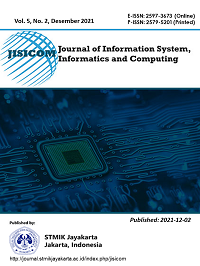Perancangan Enterprise Architecture Dengan Modified Togaf Adm Pada PT Ilmu Komputercom Braindevs Sistema
Abstract
PT IlmuKomputerCom Braindevs Sistema adalah perusahaan yang bergerak di bidang jasa Pengembang Enterprise Architecture dan Software Development. Dengan mengusung visi menjadi perusahaan pengembang Enterprise Architecture dan Software Development dengan kualitas terbaik di Indonesia, maka dibutuhkan standar prosedur, tata kelola serta perencanaan perusahaan yang baik agar visi tersebut tercapai. Selain itu karena belum adanya dokumentasi perusahaan yang kemprehensif, maka seringkali pengambilan keputusan dilakukan secara ad hoc. Karena itu dibutuhkan suatu perancangan enterprise architecture sebagai cetak biru perusahaan yang menyelaraskan visi dan misi perusahaan dengan proses bisnis dan teknologi informasi berupa data, aplikasi dan teknologi yang akan menghasilkan roadmap atau rencana strategis perusahaan. Pada penelitian ini dalam pengembangan enterprise architecture menggunakan kerangka kerja TOGAF ADM yang telah dimodifikasi, karena lebih mudah dan komprehensif untuk diterapkan di PT IlmuKomputerCom Braindevs Sistema.
Downloads
References
[2] R. Yunis and K. Surendro, “Perancangan Model Enterprise Architecture Dengan Togaf,” Snati, vol. 2009, no. Snati 2009, pp. 25–31, 2009.
[3] R. S. Wahono, Pengembangan Enterprise Architecture PT Pembangkitan Jawa-Bali. Surabaya: PT IlmuKomputerCom Braindevs Sistema, 2018.
[4] P. Saha, “Enteprise Architecture as Platform for Connected Government -- Understanding the Impact of Enterprise Architecture on Connected Government,” 2010.
[5] J. A. Zachman, “Framework for information systems architecture,” IBM Syst. J., vol. 38, no. 2, pp. 454–470, 1999, doi: 10.1147/sj.382.0454.
[6] A. Tang, J. Han, and P. Chen, “A comparative analysis of architecture frameworks,” Proc. - Asia-Pacific Softw. Eng. Conf. APSEC, no. January, pp. 640–647, 2004, doi: 10.1109/APSEC.2004.2.
[7] The Federal CIO Council, “Federal Enterprise Architecture Framework,” no. September, 1999.
[8] M. A. Mohamed, G. H. Galal-Edeen, H. A. Hassan, and E. E. Hasanien, “An evaluation of enterprise architecture frameworks for E-government,” Proc. - ICCES 2012 2012 Int. Conf. Comput. Eng. Syst., pp. 255–260, 2012, doi: 10.1109/ICCES.2012.6408524.
[9] B. D. Rouhani, M. N. ri Mahrin, F. Nikpay, and P. Nikfard, “A comparison enterprise architecture implementation methodologies,” Proc. - 2013 Int. Conf. Informatics Creat. Multimedia, ICICM 2013, pp. 1–6, 2013, doi: 10.1109/ICICM.2013.9.
[10] M. De Vires, “A framework for understanding and comparing enterprise architecture models,” … Dyn. J. South. African …, vol. 19, no. 2, pp. 17–30, 2010, [Online]. Available: http://reference.sabinet.co.za/sa_epublication_article/mandyn_v19_n2_a2.
[11] R. Sessions and J. DeVadoss, “A Comparison of the Top Four Enterprise Architecture Approaches in 2014 by Roger Sessions and John deVadoss Table of Contents,” Microsoft Dev. Netw. Archit. Cent., p. 57, 2014.
[12] The Open Group, “The TOGAF® Standard V9.2 Reference Cards,” pp. 1–16, 2018.
[13] B. Scholtz et al., “An Analysis of the Adoption and Usage of Enterprise Architecture,” 2013.
[14] S. Kotusev, “TOGAF-based enterprise architecture practice: An exploratory case study,” Commun. Assoc. Inf. Syst., vol. 43, no. 1, pp. 321–359, 2018, doi: 10.17705/1CAIS.04320.
[15] R. Ansyori, N. Qodarsih, and B. Soewito, “A systematic literature review: Critical Success Factors to Implement Enterprise Architecture,” Procedia Comput. Sci., vol. 135, pp. 43–51, 2018, doi: 10.1016/j.procs.2018.08.148.
[16] D. Carr and S. Else, “State of Enterprise Architecture Survey: Results and Findings,” EAPJ J., no. May, 2018.
[17] The Open Group, “An Overview of TOGAF Version 9.1,” Publ. by Open Gr., p. 43, 2011.
[18] D. Greefhorst, H. Koning, and H. Van Vliet, “The many faces of architectural descriptions,” Inf. Syst. Front., vol. 8, no. 2, pp. 103–113, 2006, doi: 10.1007/s10796-006-7975-x.
[19] P. Harmon and C. Wolf, “The State of Business Process Management,” A BPTtrends Rep., pp. 1–52, 2016, [Online]. Available: http://www.bptrends.com/bpt/wp-content/surveys/2012-_BPT SURVEY-3-12-12-CW-PH.pdf.
[20] Kendal, Systems Analysis & Design. 2019.

This work is licensed under a Creative Commons Attribution 4.0 International License.























.png)
.png)


